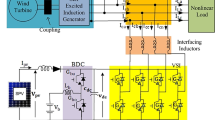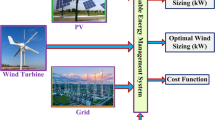Abstract
In most isolated sites situated in south Algeria, the diesel generators are the major source of electrical energy. Indeed, the power supply of these remote regions still poses order problems (technical, economical and ecological). The electricity produced with the help of diesel generators is very expensive and responsible for CO2 emission. These isolated sites have significant wind energy potential. Hence, the use of twinning wind-diesel is widely recommended, especially to reduce operating deficits. The objective of this paper is to study the global modeling of a hybrid system which compounds wind turbine generator, diesel generator and storage system. This model is based on the control strategy to optimize the functioning of the hybrid system and to consolidate the gains to provide proper management of energy sources (wind, diesel, battery) depending on the load curve of the proposed site. The management is controlled by a controller which ensures the opening/closing of different power switches according to meteorological conditions (wind speed, air mass, temperature, etc).
Similar content being viewed by others
References
Baños R, Manzano-Agugliaro F, Montoya F G, Gil C, Alcayde A, Gómez J. Optimization methods applied to renewable and sustainable energy: a review. Renewable & Sustainable Energy Reviews, 2011, 15(4): 1753–1766
Ngan M S, Tan C W. Assessment of economic viability for PV/ wind/diesel hybrid energy system in southern Peninsular Malaysia. Renewable & Sustainable Energy Reviews, 2012, 16(1): 634–647
Bellarbi S, Kasbadji Merzouk N, Malek A, Larbes C. Modeling and simulation of wind energy chain conversion. Desalination andWater Treatment, 2013, 51(7–9): 1434–1442
Global Wind Energy Council (GWEC). Global Wind Energy Report: Annual Market Update 2013. 2014–10–03, http://www. gwec.net/wp-content/uploads/2014/04/GWEC-Global-Wind- Report_9-April-2014.pdf
Basbous T, Younes R, Ilinca A, Perron J. A new hybrid pneumatic combustion engine to improve fuel consumption of wind-diesel power system for non-interconnected areas. Applied Energy, 2012, 96: 459–476
Saheb-Koussa D, Haddadi M, Belhamel M. Feasibility, study and optimization of hybrid system (wind-photovoltaic-diesel) to supply electric power completely autonomy. Journal of Fundamental and Applied Sciences, 2010, 2(1): 84–95
Hunter R, Elliot G. Wind-Diesel Systems: a Guide to the Technology and Its Implementation. Cambridge: Cambridge University Press, 1994
Hamane L, Khellaf A. Wind Energy Resources in Algeria. Pergamon, Amsterdam, PAYS-BAS, 2000, 2352–2355 (in Anglais)
URER-MS.Weather station of the Renewable Energy Research Unit in Saharian Medium (URER-MS) Adrar, Algeria. 2014–09–24, http:/urerms.cder.dz/
Kamal E, Koutb M, Sobaih A A, Abozalam B. An intelligent maximum power extraction algorithm for hybrid wind-dieselstorage system. International journal of Electrical Power & Energy Systems, 2010, 32(3): 170–177
Ibrahim H, Younès R, Basbous T, Ilinca A, Dimitrova M. Optimization of diesel engine performances for a hybrid winddiesel system with compressed air energy storage. Energy, 2011, 36(5): 3079–3091
Sebastián R, Alzola R P. Effective active power control of a high penetration wind diesel system with a Ni-Cd battery energy storage. Renewable Energy, 2010, 35(5): 952–965
Sebastian R. Modelling and simulation of a high penetration wind diesel system with battery energy storage. International Journal of Electrical Power & Energy Systems, 2011, 33(3): 767–774
Kassem A M, Yousef A M. Robust control of an isolated hybrid wind-diesel power system using linear quadratic Gaussian approach. International Journal of Electrical Power & Energy Systems, 2011, 33(4): 1092–1100
Ghedamasi K, Azouzellag D. Improvement of performances for wind energy conversions systems. International Journal of Electrical Power & Energy Systems, 2010, 32(9): 936–945
Sedaghat B, Jalilvand A, Noroozian R. Design of a multilevel control strategy for integration of stand-alone wind/diesel system. International Journal of Electrical Power & Energy Systems, 2012, 35(1): 123–137
Heier S. Grid Integration ofWind Energy Conversion Systems. John Wiley and Sons Ltd., 1998
Mirecki A, Roboam X, Richardeau F. Architecture complexity and energy efficiency of small wind turbines. IEEE Transactions on Industrial Electronics, 2007, 54(1): 660–670
Knight A M, Peters G E. Simple Wind energy controller for an expanded operating range. IEEE Transactions on Energy Conversion, 2005, 20(2): 459–466
Lotfi S, Sajedi M. Modeling and application of permanent magnet synchronous generator (PMSG) based variable speed wind generation system. International Journal of the Physical Sciences, 2012, 7(3): 370–376
Farida M. Controlling a wind energy system based on a permanent magnet synchronous generator. Dissertation for the Master’s Degree. Batna: University Hadj Lakhdar Batna, Algeria, 2013, 50
Ismail M S, Moghavvemi M, Mahlia T M I. Techno-economic analysis of an optimized photovoltaic and diesel generator hybrid power system for remote houses in a tropical climate. Energy Conversion and Management, 2013, 69: 163–173
Dufo-López R, Bernal-Agustín J L. Design and control strategies of PV/diesel systems using genetic algorithms. Solar Energy, 2005, 79 (1): 33–46
Linden D, Reddy T B, eds. Handbook of Batteries, 3rd ed. McGrawHill, 2002
Tremblay O, Dessaint L A, Dekkiche A I. A generic battery model for the dynamic simulation of hybrid electric vehicles. In: Proceedings of the 2007 IEEE Vehicle Power and Propulsion Conference VPPC. Arlington, USA, 2007, 284–289
Author information
Authors and Affiliations
Corresponding author
Rights and permissions
About this article
Cite this article
Allali, K., Azzag, E.B. & Kahoul, N. Wind-diesel hybrid power system integration in the south Algeria. Front. Energy 9, 259–271 (2015). https://doi.org/10.1007/s11708-015-0367-5
Received:
Accepted:
Published:
Issue Date:
DOI: https://doi.org/10.1007/s11708-015-0367-5




